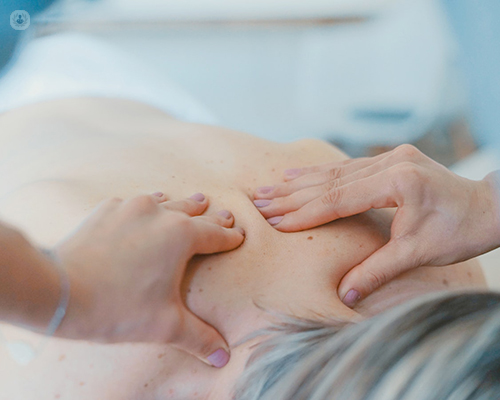Bursitis: of the shoulder, elbow, hip, knee or foot
Autore:Bursitis is a relatively common condition that causes aches and tenderness in the affected areas of the body. Bursae are fluid-filled sacs that cushion the bones, tendons and muscles near the joints. When the sacs become swollen and inflamed, the condition is known as bursitis. The commonest locations for this to occur are the shoulder, elbow and hip. Bursitis can also affect the knee, heel and the area at the base of the toes.
Leading orthopaedic surgeon Mr Andrew Fitzgerald discusses what happens when each of these areas is affected and how they are treated.

Shoulder bursitis
Shoulder bursitis can be due to repetitive overuse of the joint and inflammation of the muscles (rotator cuff tendons) or can be related a single more significant injury such as a fall. Typical symptoms include:
- Pain over the outside top of the shoulder
- Difficulty and discomfort lying on the affected area
- Pain that is worse when lifting the arm to the side of pushing with the arm
An MRI or ultrasound scan of the shoulder may be required to assess the bursa and to see if there is associated inflammation or impingement of the shoulder tendons.
Local anaesthetic and corticosteroid injections into the bursa and joint can provide effective pain relief with concurrent physiotherapy treatment. Arthroscopic surgery is rarely required.
Elbow bursitis
Elbow bursitis affects the olecranon bursa, which is a thin fluid sac located at the bony tip of the elbow at the back. The condition is characterised by swelling, redness and pain at the tip of the elbow that results in a golf ball-sized lump.
Simple home treatment involves rest, ice and anti-inflammatories. If the swelling is persistent, the fluid can be drained by an aspiration to relieve pressure and pain. Corticosteroid injections can also be carried out. Secondary infections usually require antibiotics or surgical drainage.
Hip bursitis
Bursitis of the hip is a common cause of hip pain and there are two main bursae in this area.
1) Trochanteric bursitis – lies over the side of the hip and causes pain, which makes it difficult to lie on the affected side. There’s a pain if you press the area and when getting up from a chair or in and out of a car. Diagnosis is usually clinical (history & examination) but ultrasound or MRI can be helpful. Most cases improve on their own but rest, ice and anti-inflammatories may be required. Injections are effective in treatment. Rarely surgery is necessary.
2) Ischial bursitis – lies between the hamstring muscles and the ischial tuberosity of the pelvis, the area of the buttock which contacts the chair when sitting. Typically pain is felt at the base of the buttock and causes problems when sitting and climbing stairs. The treatment is the same as trochanteric bursitis.
Knee bursitis
There are multiple bursae around the knee, but the commonest bursa affected by inflammation and swelling are:
• Prepatellar bursa (Housemaid’s knee) – in front of the kneecap
• Infrapatellar bursa (Clergyman’s knee) – below the kneecap
• Pes anserinus bursa – inside and just below the knee over the shin bone
• Suprapatellar bursa – above the kneecap
The symptoms of bursitis around the knee include swelling, redness and warmth at the affected site. This limits the movement of the knee. Diagnosis should rule out if there is an infection in the knee joint, which may cause significant pain alongside general symptoms such as malaise, sweating and rigours.
The diagnosis of knee bursitis is usually clinical, discussing the patient history and with an examination, but an ultrasound or MRI scan can be helpful. Treatment includes rest, ice and anti-inflammatories. Physiotherapy is beneficial in the longer term to assess any underlying biomechanical causes that could contribute to the problem and so reduce the chances of recurrence.
If a bursa becomes infected then treatment with antibiotics is usually necessary and occasionally drainage of the infected bursa. Surgical intervention otherwise is rarely required but if necessary can involve removal of the affected bursa.
Foot bursitis
This can affect the area around the heel as well as the bursae underneath the sole at the base of the toes and over the inside of the foot, at the base of the big toe. Foot bursitis may be caused by overuse as well as acute injuries. Poorly fitting footwear can contribute to the development of the condition, as can underlying inflammatory conditions.
Signs and symptoms include swelling, redness and warmth and tenderness over the affected area. These are made worse with walking or running or wearing certain footwear.
Investigations into the diagnosis include X-rays, ultrasound scans and MRI scans. Treatment in the majority of cases may involve rest, ice and elevation and the avoidance or modification of strenuous activities. Anti-inflammatories may also be beneficial.
Physiotherapy can be of benefit with the use of manual therapeutic techniques as well as exercises including stretches and strengthening exercises. The use of ultrasound, electrical stimulation heat and cold treatment can help reduce the inflammation and pain from bursitis. An important part of treatment involves assessing the patient for any underlying mechanical issues and the involvement of gait analysis and properly fitted footwear for the individual and podiatry insoles can also be of benefit in prevention of longer-term problems.
If the bursal swelling is very severe then occasionally drainage off the fluid can be carried out. The use of injections using local anaesthetic and corticosteroid may also be beneficial to the affected area. Surgical treatment is not usually required but can involve the removal of the affected bursa.
Book an appointment with Mr Fitzgerald now if you're concerned about bursitis.


